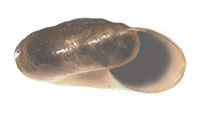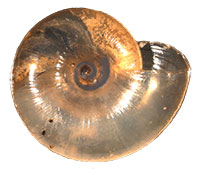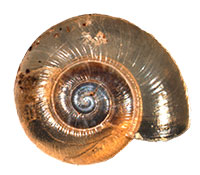Virginia Land Snails



Photo(s): The light-brown shell of Glyphyalinia cumberlandiana. Image by Dan Dourson ©.
Click photo(s) to enlarge.
Glyphyalinia cumberlandiana (Clapp, 1919)
Family: Zonitidae
Common name: Hill Glyph
Identification
Width: 3.0-3.1 mm
Height: 1.2-1.3 mm
Whorls: 3.9-4.1
Glyphyalinia cumberlandiana is very small for its genus. The shell is relatively depressed, the apical surface of the moderately rapidly expanding whorls are nearly flat. The umbilicus is wide, nearly a quarter of the shell width. The shell is smooth, shiny and translucent light-brown. The shell surface is sculptured with weak growth lines as well as relatively closely spaced narrow indentations that run parallel to the growth lines. In addition, there are microscopic weak impressed lines that run parallel to the shell spiral. The dorsal surface of the body and mantle edge are dark bluish. Internally, the apex of the penis contains conical papillae similar to species of Pilsbryna.
Ecology
This species is usually found in deep pockets of moist leaf litter near small streams, ditches, and seeps in rocky forests. Although, reported from non-calcareous soils by Baker, its preferred habitats are on basic or neutral soils (Nekola, 2010).
Taxonomy
Glyphyalinia cumberlandiana has also been known as Polita cumberlandiana and Retinella cumberlandiana.
Distribution
The species is found in the southern Appalachian Mountains from western Maryland to northeastern Alabama. In Virginia G. cumberlandiana is found west of the Shenandoah Valley, especially in the southwestern counties.
NatureServe Global Rank: G4
NatureServe State Rank: S3
John Slapcinsky 10/2012
Range Map.jpg)



